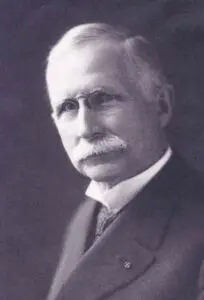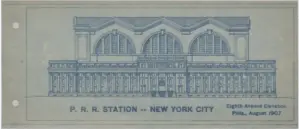Joseph T. Richards: Laying the Tracks for Modern Transportation
Other Blogs
- 2023 Commencement Speaker
- Joseph T. Richards: Laying
- Service Above Self: Teacher and
- My Four Year WNA Experience
- Col. Richard R. Hallock ’37 – A Legacy of Service
- Traveling Again
- “Nothing Without Work”
- Marathoning March
- Press Release: New Academic Program
- Instructions for accessing MySchoolApp
- WNA Launches Center for Creative Exploration
Joseph T. Richards
(1845-1933)
As the oldest boarding school in the United States, West Nottingham Academy is truly a special place to learn and to grow as an individual. What establishes WNA as an institution of such historical relevance is the people. The people who have walked through the halls and the classrooms of the Finley-Bathon Hall, as well as the people that have worked for or supported this incredible school.
One former alumnus certainly left a major impact on the world and the people around him. His name was Joseph T. Richards.
Early Life
Richards was born on his family’s farm, Oak Farm, near Porters Bridge, west of Rising Sun in Cecil County, Maryland on February 12, 1845. He was one of seven siblings raised by his parents, Isaac and Mercy Richards. Richards remained close to the area for his schooling and received his secondary education from West Nottingham Academy. As Richards came of age, he demonstrated a clear passion for engineering and design and is said to have drawn some of his first architectural sketches at West Nottingham. After he completed his education, Richards began his career in August of 1869 by entering the service of the Pennsylvania Railroad Company as a Rodman and Transitman in Altoona, PA. In this role, Richards would oversee transporting, setting up, and the utilization of the instruments that were used to survey land.

Career
In 1871, Richards was promoted and accepted the position of Chief Engineer and was responsible for locating and constructing minor railroads in Maryland. Under this title, the Engineer built and maintained the Kent County Railroad. Richards’ work was not going unnoticed by his superiors. Over the next twenty years, he was promoted over five times. On March 1, 1893, when a change was made within the organization, Richards became Engineer of Maintenance of Way for the Pennsylvania Railroad.
In 1903, the railroad industry began to take notice of Richards’ railway contributions. Richards was appointed to the role of Chief Engineer, Maintenance of Way for the Pennsylvania Railroad. This critical appointment would turn out to become Richards’ most successful and prominent position. During his service as the Chief Engineer, Richards largely influenced the standards established for tracks, bridges, operating yards, and most importantly train stations–some of which we still use today. In 1907, in addition to his duties as Chief Engineer, Richards was made Chairman of several committees for establishing and implementing the plans for the Washington, D.C., and New York City train stations, terminals, and yards. In this role, Richards gave great thought and much attention to the study of railroad stations and yards and largely influenced the working plans for the New York City, Long Island New York, and Washington D.C. terminals.
Richards participated in several large construction projects in his career with the Pennsylvania Railroad. The most prominent project he helped work on was Pennsylvania Station (Penn Station) in New York City. As Chief Engineer and as the chairman of three additional committees of Pennsylvania Railroad operating officers, Richard set the operating parameters for the design of the station–one of the largest and most heavily used train stations in United States’ history.

Modern Day Impact
Today, Penn Station in New York City is a transportation flagship in the largest city in the United States. In 2019, it was the busiest train station in the Western Hemisphere serving over 650,000 people a day. With tunnels and tracks still intact from the original construction in the early 1900s, the legacy of Penn Station and Richards continues today.
In early 2021, Penn Station unveiled its brand-new Moynihan Train Hall—an expanded section of Penn Station built for Amtrak service. Moynihan Train Hall is named after the late Senator Daniel Patrick Moynihan, a Navy veteran who represented New York for 24 years. Since 2017, the Moynihan Station has undergone a $1.6 billion renovation, transforming the James A. Farley Post Office, an adjacent building to Penn Station, into an updated facility that expands the station’s concourse space by 50 percent. This project has now allowed the United States’ busiest rail terminal to expand by 255,000 square feet and has provided more room and space for the 650,000 people who traveled through the station every day (before the pandemic).
“This monumental accomplishment is a shot of hope as we come out of one of the darkest periods in our history,” said New York Governor Andrew Cuomo in a late 2020 statement, “It sends a clear message to the world that while we suffered greatly as a result of this once-in-a-century health crisis, the pandemic did not stop us from dreaming big and building for the future. The new Moynihan Train Hall is the embodiment of ‘New York tough’.”

Although the original terminal was torn down and rebuilt, Penn Station has remained an important fixture in the hearts of citizens from New York City and everyone who passes through its gates every day—or ever so often.
Richards retired from the Pennsylvania Railroad in 1913 to spend time with his wife, Martha, and his four daughters and son. In 1933, he passed away at the age of 88 in Cape May, New Jersey where he spent his later years.
Joseph T. Richards was a notable influence in railroad design and played a critical role in the history of United States transportation. Richards got his start at West Nottingham Academy and is just one of many extremely bright and talented people who have walked our halls.
Author Will Farrington is a 2019 graduate of Towson University with a bachelor’s degree in Mass Communication. He has worked for West Nottingham Academy since January 2021 as the Marketing and Development Intern. Will has been local to the Rising Sun area for most of his life.

Opportunity awaits you at West Nottingham Academy!
Every day, in every activity, from the classroom to the playing fields, art studios, and club gatherings, students are exposed to a diverse community of learners from all walks of life.
